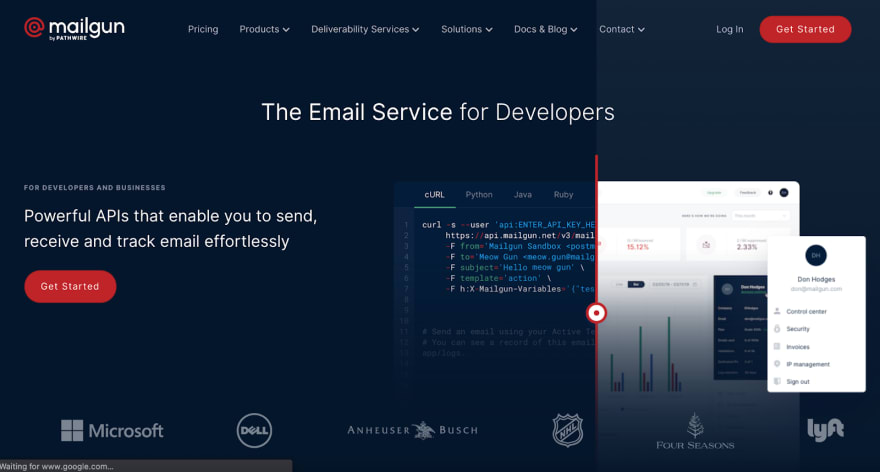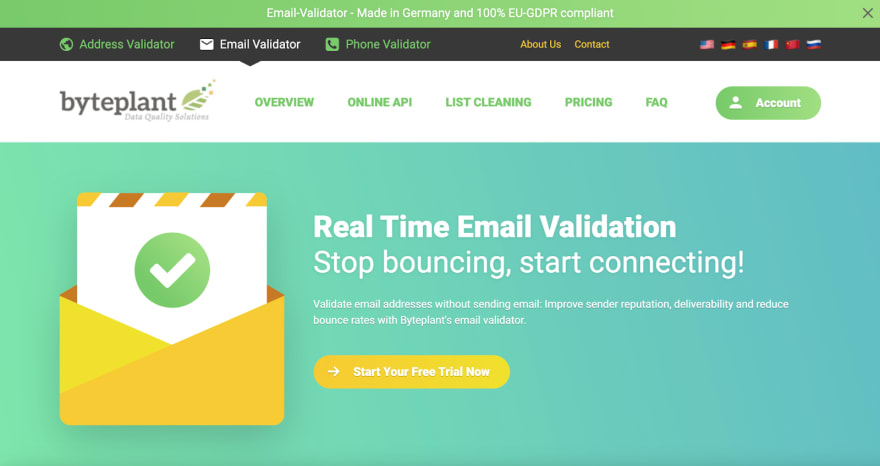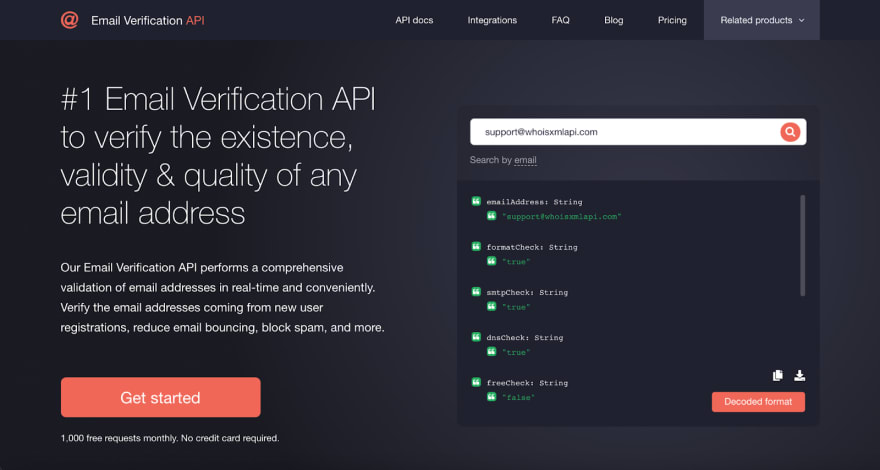Some may say that email marketing is the way to go. For developers, that means creating products that can help organizations boost their marketing performance. One way to do that is by producing an email verification API their fellow developers can implement in their respective companies while keeping these latest stats in mind:
- The worldwide email user base in 2019 was 3.9 billion, which is slated to reach 4.5 billion by 2024.
- A 2019 Campaign Monitor study of 1,000 small business owners ranked email marketing as the second most effective means to build brand awareness. Email marketing, in fact, had the highest return on investment (ROI) for small businesses.
An effective email verification API should help users clean up their distribution lists to avoid high bounce rates. Why? Because high bounce rates could land their domains on spam blocklists, which could affect their reputation and, consequently, bottom line significantly. For the companies’ development team, that translates to failure as well.
One way to keep invalid email addresses (i.e., those that lead to hard bounces) out of distribution lists is by employing an email verification API. But that’s not all email validation is good for. It’s also useful for ramping up cybersecurity, keeping freemium abusers out of product pages, and avoiding spam traps, which are a few of the goals developers are hired for as well.
What Is an Email Verification API Good For?
Email verification APIs validate if an email address exists and can receive messages through various checks. Using them can help companies enjoy several benefits. But creating your own email verification API can take months. Pooling the data required to build a database and updating it daily isn’t easy. Instead of building one from scratch, you can opt to integrate a reliable API into your existing systems and solutions instead to get the advantages cited below.
Help Keep Your Organization’s Bounce Rate to a Minimum
You probably know that the higher a company’s bounce rate is, the lower its email-sending reputability is. In fact, your email-sending reputation has a lot to do with how effective your marketing efforts are. The lower your bounce rate, the more likely your intended recipients are to receive and read your emails. The opposite, however, is bound to land your domain on a spam blocklist. That means none of your customers, current and potential, may never even have a chance to see your emails in their inboxes.
An effective email verification API uses email-sending simulation techniques to ensure the validity of an address. It checks if it has all the necessary components (e.g., a corresponding inbox, a mail exchanger [MX] server and records, the proper format, etc.) to receive messages. All these checks help ensure your marketing messages get to their intended destinations.
Help Your Organization Keep Catch-All Email Addresses Out
A catch-all email address is designed to catch all messages for a number of users. Some of these users may no longer be part of the company. Others rarely, if at all, check the catch-all inbox much less read or respond to emails sent to it.
Sending emails to a catch-all email address could translate to a high bounce rate and so on and so forth. You can avoid this cycle by using an email verification API that flags catch-all email addresses on the fly.
Help Your Organization Keep Potential Freemium Abusers and Fraudsters Out
While not everyone who uses an invalid or temporary email address is a freemium abuser or cybercriminal, some could be. A potential scenario could be that the user mistyped his or her email address while signing up for an account. And disposable email address users could just be protecting their privacy.
An email verification API can lessen the likelihood that your distribution list contains addresses that could potentially belong to free trial abusers who use disposable addresses to sign up multiple times so they can keep using your product without ever having to pay. It can also keep threat actors who use temporary email addresses containing legitimate brand names out of your network. An example would be microsoft@[disposable domain].[TLD]. This address could trick you into thinking you’re communicating with a user from Microsoft when you’re actually not.
What Do You Need to Consider When Choosing an Email Verification API?
An effective email verification API should run various checks to validate an email address. These tests include the following:
- Format check: All valid email addresses follow this format:
Local-part (owner’s or department name) + @ + domain name (company or email service provider’s name)
An invalid email address doesn’t follow this format and will get the following result from an email verification API format check:
formatCheck: String
"false"
- Simple Mail Transfer Protocol (SMTP) check: All valid email addresses should have connected mailboxes to receive messages. An invalid email address that doesn’t have one will get this result from an email verification API’s SMTP check:
smtpCheck: String
"false"
- Domain Name System (DNS) and MX record check: All valid email addresses should have existing domains or a working MX server to receive messages. An invalid email address will get this result from an email verification API’s DNS and MX record check:
dnsCheck: String
"false"
mxRecords: Array
0:
1:
2:
- Free check: Just like legitimate users, threat actors can also get email addresses from free email services like Gmail, Yahoo, and many others. If you want to keep them out of your subscription list, watch out for email addresses that get this result from an email verification API’s free check:
freeCheck: String
"true"
- Disposable check: Many freemium abusers use temporary email addresses so they can sign up for free trials multiple times thereby being able to use products without paying for them ever. Be wary of email addresses then that get this result from an email verification API’s disposable check:
disposableCheck: String
"true"
- Catch-all check: Messages sent to catch-all addresses rarely or never get opened. Watch out for email addresses then that give this result for an email verification API’s catch-all check:
catchAllCheck: String
"true"
Most email verification APIs give results in JavaScript Object Notation (JSON) or eXtensible Markup Language (XML) format. But some provide more readable and shareable reports via custom URLs that when clicked opens the report specifically for the email address queried.
What Email Verification APIs Should Be on Your Selection List?
We compared seven email verification APIs based on the six tests we believe an effective tool should perform to validate email addresses so you can spend less time and effort looking for the right fit for your company.
Email Verification API
Email Verification API performs comprehensive checks on email addresses that website visitors use for registration. As such, it helps reduce email bounces, block spam, and more. It ensures that an email address follows the correct format and has a working SMTP connection and an MX server. It also alerts users if the email address is a free, disposable, and/or catch-all address.
Users can enjoy the tool’s benefits for as little as US$18 for 10,000 queries a month.
Results come in JSON format or a more readable report with a shareable custom link.
emailAddress: String
"support@whoisxmlapi.com"
formatCheck: String
"true"
smtpCheck: String
"true"
dnsCheck: String
"true"
freeCheck: String
"false"
disposableCheck: String
"false"
catchAllCheck: String
"true"
mxRecords: Array
0:
"alt1.aspmx.l.google.com."
,
1:
"aspmx2.googlemail.com."
,
2:
"aspmx.l.google.com."
,
3:
"aspmx3.googlemail.com."
,
4:
"alt2.aspmx.l.google.com."
,
audit: Object
auditCreatedDate:
"2021-07-21 01:01:48.000 UTC"
,
auditUpdatedDate:
"2021-07-21 01:01:48.000 UTC"
QuickEmailVerification

QuickEmailVerification performs five of the six email validation checks mentioned earlier. It prevents email addresses with the incorrect format and without an SMTP connection from ending up in your distribution list. It flags free, disposable, and catch-all email addresses, too.
Using the tool costs US$420 monthly and allows for 15,000 queries a day. However, more plans are available as well.
It gives results in JSON format.
Mailgun

Mailgun targets developers who want to integrate email validation into their products. It performs two of the six tests to validate email addresses—format and free checks.
Users can harness the tool’s power by paying a minimum of US$35 for 50,000 queries a month.
It gives results in JSON format.
Email Verifier API

Email Verifier API checks if an email address follows the required format, ensures that it isn’t from a free service provider, and determines if it is a disposable and/or catch-all address.
Users can use the tool for a one-time payment of US$70 for 10,000 queries.
Results come in JSON and XML formats.
Trumail

Trumail performs four checks—format, free, disposable, and catch-all—on a given email address and provides JSON, JSONP, and XML results.
Users can enjoy the benefits the tool provides at US$69 for 10,000 queries.
{
"address": "support@whoisxmlapi.com",
"username": "support",
"domain": "whoisxmlapi.com",
"md5Hash": "02364a441d5b4021790e20e84c214131",
"suggestion": "",
"validFormat": true,
"deliverable": true,
"fullInbox": false,
"hostExists": true,
"catchAll": true,
"gravatar": false,
"role": true,
"disposable": false,
"free": false
}
SendGrid

SendGrid checks if an email address meets required formatting specifications, if it has a corresponding MX server and DNS records, and if it was created via a free email service.
Users can make 10,000 basic queries for US$14.95 a month.
Results come in JSON format.
Email Validator

Email Validator performs all six checks—format, SMTP, DNS and MX, free, disposable, and catch-all—on a given email address, providing results in JSON format.
Querying 10,000 email addresses costs US$59 a month.
Given the ideal list of checks an email verification API is expected to perform, we hope you find the right fit for your requirements from among the choices listed in this post.





Top comments (0)